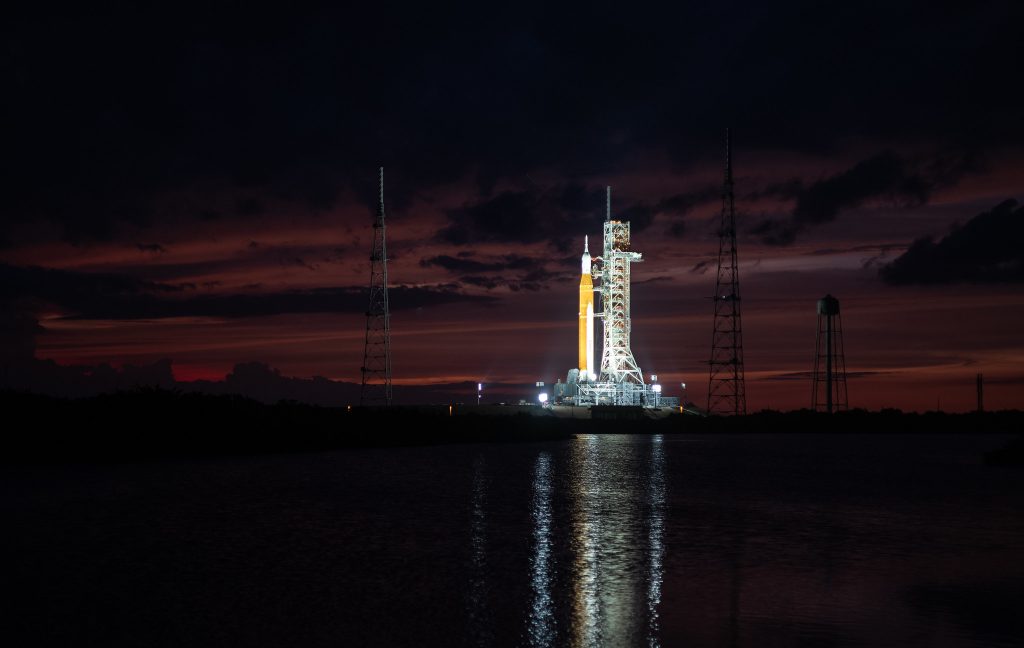NASA and the city of Cape Canaveral are working with citizens on immediate and long-term solutions to sea-level rise.
In a city that prides itself in being the futuristic “Spaceport of America,” Cape Canaveral also faces a different future already obvious in the flooding that occurs during big storms: climate change.
When NASA’s Florida space center opened in 1962, the problem wasn’t rising seas and greenhouse gases. It was winning the race to space. (The center was named for President John F. Kennedy shortly after his assassination in 1963.) A thin barrier island between the Banana River Lagoon and the Atlantic Ocean on the east coast of Florida was an ideal location for the space center. Being on the coast and near the equator made it a perfect launch site, giving rockets a boost from the Earth’s eastward rotation as they launch into orbit. The Atlantic also provides a safety net for parts such as boosters designed to fall off and splash back to earth.
But now, climate change makes the Atlantic an increasing hazard to both Kennedy and the city of Cape Canaveral, which incorporated in 1963 and grew to be defined by the space program. The beaches that protect the launchpads from storm surges and natural disasters are quickly eroding. The rate of sea-level rise along the barrier island has more than doubled from 0.06 inches a year for most of the 20th century to 0.14 inches a year between 2006–2015. This rise is driven by melting ice sheets and glaciers and the thermal expansion of ocean water due to increasing global temperatures.
NASA, the space center, the city and its 10,000 residents are all at the frontlines of rising seas and increasing risks from hurricanes and other storms. They are also at the frontlines of finding answers as they work together to preserve land and get the community involved in resilience, two crucial solutions for adapting to climate change.
“We’re doing a lot to ensure that we are sustainable long into the future,” said Thomas O. “Tom” Engler, director of Center Planning and Development at Kennedy Space Center. “We want to continue to capitalize on the over 60 years of spaceflight, experience and history that we have [in Cape Canaveral] and continue to inspire the nation and the world with what we’re doing.”
As a first line of defense, NASA and the city are working on artificial dune projects. John Jaeger, an associate professor in geology at the University of Florida, was one of the first to quantify the effects of climate change on NASA’s beaches. Locals stressed, “we’ve got a real bad coastal erosion problem.”

Jaeger and his team drove up and down NASA’s six-mile coastline in ATVs every month for four years from 2009-2013, collecting elevation data and beach erosion impact. As the shorelines retreated due to sea rise, the team recommended that property owners and NASA build and restore protective dunes. Since then, NASA finished a four-and-a-half-mile dune construction project that brought in 38,000 loads of sand to strengthen the dunes, and planted vegetation on top to make them more resilient.
The city and citizens are also working to bolster the dunes. As part of Cape Canaveral’s annual Sea Oats Planting Project, the city and volunteers have planted more than 100,000 sea oats to help fortify the beaches. The city’s Adopt-A-Mangrove Program helps property owners plant and care for the natural lines of defense.
Reinforcing the coastline is one of NASA’s initiatives. Long term, the agency is keeping an eye on sea rise as it plans future building and launchpad construction around already disturbed land and high-elevation areas. Currently, 7,500 acres of NASA’s 141,829-acre area are used for space mission operations, leaving around 95% of the total land undisturbed.
“We really only have about another 7,500 acres that can be developed,” Engler said. “So we are very carefully managing the type of development that’s happening on the center and also where it’s being developed to be able to minimize the impacts of sea level rise.
“Of course, there will be that impact as we move forward,” he said. “So part of the planning is also looking at things we can do to harden existing facilities that cannot be moved.”
Moving operations from Cape Canaveral is not in Kennedy Space Center’s current plans, he said.
Just south of the space center, the city of Cape Canaveral covers just 2.3 square miles at a thin part of the barrier island, making it especially vulnerable to sea level rise and the intense effects of storm surges. After Hurricane Nicole made landfall to the south at Vero Beach in the wee hours of Nov. 10, Cape Canaveral business owners saw firsthand the damage that water disasters can have on the community. Nicole caused NASA to delay its Artemis-1 launch—after rolling the rocket back earlier in the fall as Hurricane Ian approached.
But locals can’t pull small businesses out of harm’s way. At Water’s Edge Bait and Tackle, workers said the water came up 5 or 6 feet following Nicole and stayed for days.
The city has put a premium on citizen awareness, and on building its sustainability and resilience plan, Cape Canaveral 2063. The number marks the anniversary of Cape Canaveral’s 100th year.
Zachary Eichholz, the city’s Chief Resilience Manager, oversaw the plan, which includes long-term projects and more urgent defenses against floods and sea rise. One of those is the use of semi-permanent flood barriers.
“Floodgates are a perfect example,” Eichholz said. “Usually with sandbags, which are terrible and time-consuming to do, especially in a hazard situation where you’re going a mile a minute. So just pop those things on.”
So far, the flood barriers are installed only at the city’s water treatment facility. But the city plans to expand installation to other vulnerable locations.
Other initiatives include building a pump station and “de-paving” the city. With much of Cape Canaveral covered in asphalt, the rain and flood waters have nowhere to go. Rebuilding roads with porous materials is another idea in the early stages of planning and development.
Eichholz and his team at city hall want to set a standard for vulnerable communities as they help Cape Canaveral find solutions. Florida is sometimes criticized for focusing on adaptation while ignoring the climate emissions causing global warming. Cape Canaveral is emphasizing both sides of the ledger, working to make solar power better available to residents and local businesses. The city is also targeting a green economy, “characterized by businesses who are efficient, clean, circular, collaborative and low-carbon.”
Still, Eichholz admits working on a challenge as big as climate change is daunting.
“It weighs on us pretty heavily,” Eichholz said. “We know that the situation can be difficult, and because of climate change, it will probably get worse. But I would also want people to know that the situation is not hopeless.”
Residents seem to appreciate the city’s resilience vibe. People in the community are largely willing to talk about tackling climate change—and they have been there for one another when it comes to defending against hurricanes.
In the wake of a hurricane, “people don’t act like they usually do,” says resident Staci Long. “It’s one of the most beautiful things you’ve ever witnessed … strangers are helping strangers.”
As climate change, rising seas and worsening storm surge continue to threaten the young city, Cape Canaveral, its residents and NASA are committed to staying put and tackling the challenges head-on, at least for now.
“When push comes to shove, I think humans are pretty darn stubborn,” says Eichholz. “And God, they like their beaches.”
 Living on the Edge
Living on the Edge